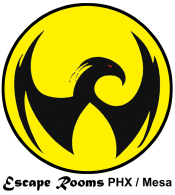The State of the Escape Room Industry
By Charles W. Bechtel, contributing editor of EscapeFront.com
Owner, Breakout Games
What, exactly, is the state of the industry, considering that escape games are relatively new but rapidly expanding? (Statistics collected mid-2017 revealed 2,800 games in the world -- today there are that many in the US alone.)

Are Escape Rooms Here to Stay
Is there a natural trajectory that the industry shall inevitably follow? Or is the escape games phenomenon simply a “whatever happens, we’re having fun while it lasts” star shooting though the constellation of business?
Here are some hard questions: are escape rooms here to stay, or are they destined to vanish just as pool halls and penny arcades did? If they stay, for how long? What will they be? Will they continue as they are, or will they evolve?
At the present moment, 2,800 escape room businesses in the U.S. claim at least $60,000 in annual revenue. Statistics indicate that fewer than 3.5% of adult Americans have visited an escape room, with only twice that number even knowing what an escape room is.
Despite this, Forbes recently predicted that within five years, 50% of adults will have been to an escape room at least once. Does this necessarily indicate strong growth potential for existing businesses? Or will it lead to hundreds of competing escape rooms cropping up only to discover an over-saturated market?
As an escape room owner, I hope so. However, in business, there is nothing easier than making a prediction, and nothing harder than making an accurate prediction.
Potential Life Cycle of the Industry
Some institutions seem to go on forever. Since the creation of the boat, there has been floating commerce; since the discovery of modern medicines, there have been drug merchants; businesses that survive the industry life-cycle do so because they’re able to adapt.
Even within these seemingly eternal institutions, businesses come and go. Most vanish because of an inability to adapt, often rooted in a fanatic adherence to the “it’s just the way we do things” mentality.
Below I’ll compare the escape games phenomenon to the rise of antique shoppes in the 1970s, and the computer centers of the 1990s.
These two industries are familiar to me for two reasons:
1) My parents dragged me into the antique business in 1969
2) I entered the computer business as a desktop publishing consultant in 1989, after a twenty-year career in dedicated computer-generated typesetting.
The Antique Industry

The housing boom of the 1960s flared because of the Baby Boomer phenomenon, and was further fueled by the number of returning Vietnam soldiers who were eligible for G.I Bill-guaranteed mortgages. Still, young people needed living accommodations, and needed to furnish them with inexpensive items. So, they raided their Grandmas’ houses and Granddads’ garages, and the antique craze was on.
Soon, several demographics were frequenting auctions and tag-sales for nostalgic items. Seeing free-to-cheap salvage flying off tables and shelves for good dollars, antiquers began turning back rooms and failing businesses into antique shoppes.
Despite all the excitement, the antique industry only flourished for about a decade. There aren’t nearly as many shoppes around today, and those that remain are typically found tucked somewhere in a nostalgically-themed, rehabbed town-center.
The Computer Sales & Repair Industry
In 1972, this author met his first typesetting computer -- an IBM Selectric typewriter -- and fell in love. Resizable type was all the rage in the late 70s, and typefaces were appearing faster than movie sequels. I became a user, then a trainer, then a consultant, and finally a salesperson of computerized typesetting.
However, the world changed in the early 1980s when Steve Jobs began releasing graphic-centric computers for a tenth of the price of dedicated typesetting machines. Soon, copier manufacturers followed suit with small, affordable printers that could print digitized type using a language called Postscript.
Suddenly, PCs were everywhere. Computer shops opened in every strip mall, selling machines and software, and repairing PCs.
In 1993, Sears began to carry DOS-based PCs. For this then-consultant, this provided a good year of work. Soon, though, everybody had an uncle or brother-in-law who could “do” what I was doing -- but they couldn’t, and I was kept busy fixing their “fixes.” PCs broke and needed upgrading or replacing, and small shops were able to handle the volume -- until the Internet gained traction.
Eventually, the ease of ordering plug-and-play components online forced computer shops and trainers out of business. There are, of course, still small repair shops out there, but hardly anyone goes to them to buy computers. Instead, people purchase from Best Buy, Walmart and Amazon.
How the Industries Compare
Much like the escape room industry, the antique and computer industries each provided a faddish opportunity that flourished rapidly once it entered the mainstream. The warning is, however, that the escape room industry may have a predetermined road to travel.
Change on the Horizon

How does an escape games business adapt? Who will succeed, and by what means?
Escape rooms may very well continue to pop up like mushrooms after a summer rain. Privately owned and operated facilities may continue to outnumber franchises.
However, new and existing escape rooms may also follow the path of roadside attractions: becoming agglomerated. This might begin with savvy entrepreneurs employing franchise models to expand into new areas, or absorbing businesses whose owners have grown tired of the extreme involvement of running an escape games facility. (Note: several franchisers already exist -- a Google search on “escape room franchises in the U.S.” returned seventeen opportunities on the first page.)
Alternatively, the franchise model could have a short shelf life for the escape room industry. Consider the example of roadside attractions. As these lost out to syndicated movie houses, live adventure venues morphed into more intensive experiences. Big fixed locations like Disneyland and Six Flags became (and remain) all the rage.
Can This Happen to Escape Rooms?
In all probability, in some form or another -- yes. So, if you own, or are planning on owning an escape room, how long are you in for? Are you preparing for the changes, or simply relying on what’s being done today? Your answers to these questions will affect your business daily.
The unpredictable factor in all of this is how the public -- the one Forbes talked about -- will continue to react to the industry. Will they find escape rooms cute and exciting on a single occasion, then return to bowling and bar-hopping? Will the recent near-total immersion in digital engagement cause a return to analog experiences and give even more impetus to the escape room industry? All of this is yet to be determined.
About the Author
Charles Bechtel is a contributing editor at EscapeFront.com and at present the owner and operator of Breakout Games. He is 65, married to Manuela Mary Bechtel, with two grown daughters and three granddaughters. Charles is a published author of numerous books, both fiction and nonfiction, has owned and operated his own publishing & consulting firms, and has even owned a charter fishing operation out of Cape May, New Jersey. He has years of marketing experience, wearing many hats on both the production and administrative sides of publishing.
